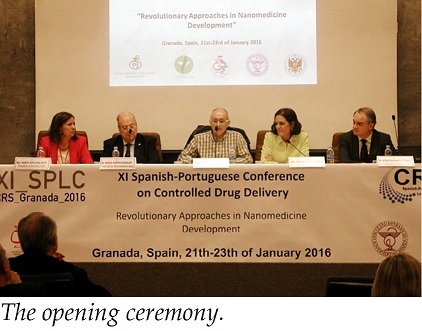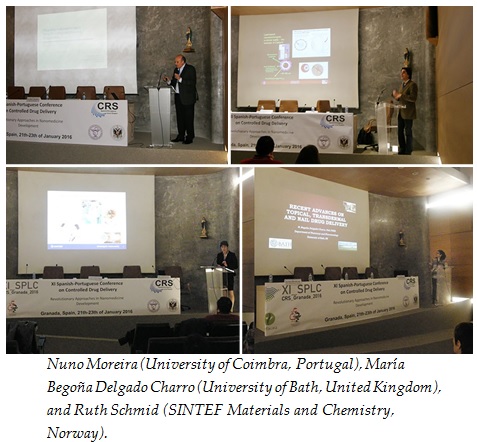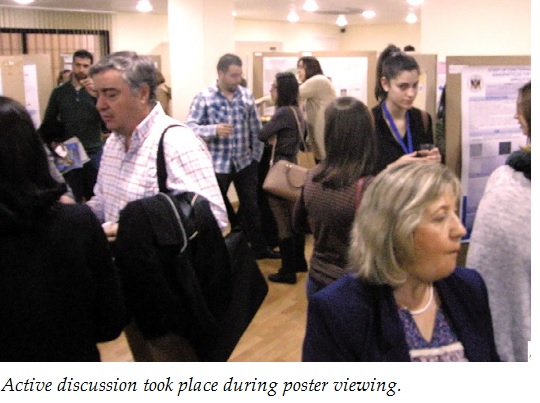Eleventh Annual Meeting of the Spanish-Portuguese CRS Local Chapter
The 11th biannual meeting of the Spanish-Portu guese CRS Local Chapter (SPLC-CRS) was held January 21–23, 2016, at the Ilustre Colegio Oficial de Farmacéuticos de Granada in Granada, Spain. The 122 participants included seven scientists from industry, 108 scientists from academia (of which 71 were students), four clinicians, and three representatives from governmental offices. The meeting was sponsored by CRS, SPLC-CRS, the University of Granada, the Faculty of Pharmacy of the University of Granada, the Ilustre Colegio Oficial de Farmacéuticos de Granada, and the Hermandad Farmacéutica Granadina (Hefagra S. Coop. And.), which allowed the organizers to invite outstanding scientists from industry, regulatory agencies, and academia as well as clinicians to present recent developments and rising trends in the converging fields of pharmacy, nanotechnology, biotechnology, and medicine, thus providing a platform for both multidisciplinary communication and new cooperation to participants from both industry and academia. The conference provided a complete overview into the state of the art in those fields, and it also allowed learning about the research done and the latest r
guese CRS Local Chapter (SPLC-CRS) was held January 21–23, 2016, at the Ilustre Colegio Oficial de Farmacéuticos de Granada in Granada, Spain. The 122 participants included seven scientists from industry, 108 scientists from academia (of which 71 were students), four clinicians, and three representatives from governmental offices. The meeting was sponsored by CRS, SPLC-CRS, the University of Granada, the Faculty of Pharmacy of the University of Granada, the Ilustre Colegio Oficial de Farmacéuticos de Granada, and the Hermandad Farmacéutica Granadina (Hefagra S. Coop. And.), which allowed the organizers to invite outstanding scientists from industry, regulatory agencies, and academia as well as clinicians to present recent developments and rising trends in the converging fields of pharmacy, nanotechnology, biotechnology, and medicine, thus providing a platform for both multidisciplinary communication and new cooperation to participants from both industry and academia. The conference provided a complete overview into the state of the art in those fields, and it also allowed learning about the research done and the latest r esults. The discussion on recent advances, difficulties, and breakthroughs was at the highest level.
esults. The discussion on recent advances, difficulties, and breakthroughs was at the highest level.
The 11th Spanish-Portuguese Conference on Controlled Drug Delivery: Revolutionary Approaches in Nanomedicine Development was opened by Pilar Aranda Ramírez (rector of the University of Granada), Ana del Moral García (dean of the Faculty of Pharmacy of the University of Granada), Antonio Mingorance Gutiérrez (president of the Consejo Andaluz de Colegios Oficiales de Farmacéuticos), Manuel Fuentes Rodríguez (president of the Ilustre Colegio Oficial de Farmacéuticos de Granada), and María Adolfina Ruiz Martínez (president of SPLC-CRS), who warmly welcomed the participants, giving also a brief introduction on the conference program. Briefly, the program included four plenary lectures
(60 minutes, including 15 minutes for lively discussion), 14 invited lectures (25 minutes, including 5 minutes for discussion), 24 oral communications (6 minutes, including one minute for discussion, spread among the sessions according to topic), and 79 poster communications (authors were near the poster at predetermined times for lively discussion) over the three days of the conference, which encompassed five sessions, including a “young session” for the young section of SPLC-CRS.
The first day started with a plenary lecture by Ángel V. Delgado (University of Granada, Spain), who provided a deep analysis of
biomedical applications of magnetic nanoparticles, at present and in the perceived future. In his talk, he first focused on the versatility of magnetic particle preparation, concerning geometry and composition, and showed that the collection of available particles is magnified when the possible coatings are studied. He further gave an overview of existing information about the toxicity of these nanovehicles, including to what extent such potential toxic effects discourage the responsible authorities from approving the use of more than just a few designs. To end the day, and thanks to the generosity of the Faculty of Pharmacy of the University of Granada, this session featured the 2013–2015 SPLC-CRS Ph.D. Thesis Award. Ana del Moral García and María Adolfina Ruiz Martínez honored the winner, who was selected after a carefully independent review process. Edorta Santos Vizcaíno (University of the Basque Country, Spain) obtained this award with his thesis “Optimization of Cell Microencapsulation in Terms of Biosafety, Biomimesis and Applicability in Therapeutic Targets of Central Nervous System.” The prize consisted of a certificate and the registration fee for the 43rd CRS Annual Meeting & Exposition ( July 2016, Seattle, Washington, U.S.A.). A talk by Santos Vizcaíno presenting his Ph.D. research closed the session. The day concluded with a guided tour of Granada, where attendees enjoyed the old part of the city and discovered some curiosities of this Andalusian city, along with a welcome drink at the Hotel AC Palacio de Santa Paula, located in a charming old convent building.
The second day began with the plenary lecture by João Nuno Moreira (University of Coimbra, Portugal), which gave an insightful vision on nanotechnology-based strategies for cancer treatment, approaching them from a tumor biology-driven perspective. Session I (Discovery and Development of Nanomedicines) included the invited lectures of Juan Antonio Muñoz Orellana (University of Granada, Spain) on the protection of pharmaceutical inventions, Juan María Alfaro Sánchez (Neuron Bioservices, Spain) on the zebrafish’s capacities to help biotech and pharmaceutical companies in the discovery and development of new drugs and nanodrugs, and Francisco Javier de la Mata (Ambiox Biotech, Spain) on carbosilane dendritic systems as a synthetic platform for the development of nanomedicines. Short talks selected from the abstracts closed this first session.
After a coffee break (poster viewing time with refreshments), session II, which was entirely organized by the young members of SPLC- CRS, featured the invited lecture of María José Alonso Fernández (University of Santiago de Compostela, Spain) on her view of current CRS activities, trying to open a discussion about the way meeting attendees might be willing to contribute to CRS and SPLC-CRS. She also summarized how CRS has influenced her scientific activity, her ultimate goal being to persuade mainly young scientists to be active in the communication and networking possibilities that both CRS and SPLC-CRS offer to them.
young members of SPLC- CRS, featured the invited lecture of María José Alonso Fernández (University of Santiago de Compostela, Spain) on her view of current CRS activities, trying to open a discussion about the way meeting attendees might be willing to contribute to CRS and SPLC-CRS. She also summarized how CRS has influenced her scientific activity, her ultimate goal being to persuade mainly young scientists to be active in the communication and networking possibilities that both CRS and SPLC-CRS offer to them.
Invited lectures from Paulo Roque Lino (University of Lisbon, Portugal) on the multivariate development of chitosan nanoparticles for the delivery of complex therapeutic human enzymes and María Carmen Leiva Arrabal (University of Granada, Spain) on experimental and clinical assays done during nanomedicine development against cancer were also included in the session. A round of short talks selected from Ph.D. student abstracts closed the session.
After lunch, the plenary lecture by Ruth Schmid (SINTEF Materials and Chemistry, Norway) focused on ultrasound-enhanced drug delivery using nanoparticle-stabilized microbubbles. She emphasized that the use of multifunctional nanoplatforms based on gas-filled microbubbles along with focused ultrasound can enhance drug delivery through biological barriers both into tumors and into the brain. Session III (New Strategies in the Treatment of Cancer and Infectious Diseases) started with an invited lecture by Ángel Montero Carcaboso (Hospital Sant Joan de Déu Barcelona, Spain). He discussed how nanotechnology can take advantage of unique genetic or biomarker alterations to enable active drug targeting to specific pediatric tumor cells. Next, the invited lecture by Jacob Lorenzo Morales (University of La Laguna, Spain) was devoted to the deep description of the combination of chemical therapies and gene silencing for the development of novel Acanthamoeba treatments. The session also included short talks selected from the abstracts.
The day ended with the SPLC-CRS General Assembly summarizing the current and prospective state of the local chapter, in which also the new directive board was elected, and with the traditional conference dinner at La Chumbera, including a fantastic flamenco show.
The last day of the conference started with a plenary lecture by María Begoña Delgado Charro (University of Bath, Great Britain) concerning recent advances on topical, transdermal, and nail drug delivery. She stressed the idea that transdermal and topical drug
delivery remain active research and development areas. Session IV (Advanced Nanotechnologies in Biomedicine) consisted of three invited lectures by María Concepción Tros de Ilarduya Apaolaza (University of Navarra, Spain), Carmen Isabel Álvarez Lorenzo (University of Santiago de Compostela, Spain), and Bruno Sarmento (University of Porto, Portugal) on targeted nonviral vectors for gene delivery, medical devices as drug delivery platforms, and nanomedicines for modulating diabetes, respectively. An active discussion on clinical translation ensued as a consequence of these three remarkable invited lectures.
Time for oral communications preceded the beginning of session V (Advanced Nanoplatforms in the Management of the Disease). Invited lectures by María Luisa González Rodríguez (University of Seville, Spain) and Mazen M. El-Hammadi (Damascus University, Syria) were included in this session. Briefly, the first lecture was devoted to the analysis of recent advances and opportunities of nanocarriers in the inflammatory process, and the second invited lecture addressed the advances and prospects of nanosystems in medical imaging.
During the concluding remarks, María Adolfina Ruiz Martínez emphasized the success of the conference and thanked all the sponsors, contributors, and attendees. Finally, the best oral and poster presentation awards were given to Sandra Cristina Campos de Jesus (University of Coimbra, Portugal) and Juan José Arroyo Crespo (Centro de Investigación Príncipe Felipe, Valencia, Spain), respectively. Sandra and Juan José each received a certificate and a €100 cheque. Here are their presentation titles and coauthors:
PCL/Chitosan Nanoparticle Adjuvant Ability for HBsAg Vaccines
Sandra Jesus, Edna Soares, and Olga Borges
Polyglutamate-Based Combination Therapy in the Treatment of Advanced Breast Cancer
Juan J. Arroyo, Coralie Deladriere, Esther Masia, Vicent J. Nebot, Alison Paul, Ana Armiñán, and María J. Vicent
More details on the 11th Spanish-Portuguese Conference on Controlled Drug Delivery can be found in the abstract book available on the SPLC-CRS website (www.splc-crs.org/index.htm) under the 2016 meeting link.

